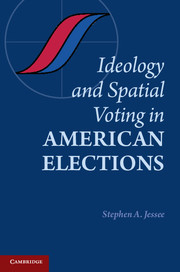Book contents
- Frontmatter
- Contents
- List of Figures
- List of Tables
- Preface
- 1 Introduction
- 2 Political Ideology
- 3 Measuring Political Ideology
- 4 Linking Theory and Empirics: Testing Spatial Voting Theory
- 5 Partisanship versus Proximity: The Effect of Party Identification on Spatial Voting
- 6 Political Information and Spatial Voting
- 7 The Political Perceptions of Citizens
- 8 Conclusion
- Appendix A Survey Question Wordings
- Appendix B Survey Sample Characteristics
- Appendix C Simplified Analyses of Ideology and Spatial Voting
- Appendix D American National Election Studies Analyses
- Bibliography
- Index
Appendix D - American National Election Studies Analyses
Published online by Cambridge University Press: 05 August 2012
- Frontmatter
- Contents
- List of Figures
- List of Tables
- Preface
- 1 Introduction
- 2 Political Ideology
- 3 Measuring Political Ideology
- 4 Linking Theory and Empirics: Testing Spatial Voting Theory
- 5 Partisanship versus Proximity: The Effect of Party Identification on Spatial Voting
- 6 Political Information and Spatial Voting
- 7 The Political Perceptions of Citizens
- 8 Conclusion
- Appendix A Survey Question Wordings
- Appendix B Survey Sample Characteristics
- Appendix C Simplified Analyses of Ideology and Spatial Voting
- Appendix D American National Election Studies Analyses
- Bibliography
- Index
Summary
This appendix presents the results of analyses of ideology and spatial voting using the 2004 and 2008 American National Election Studies (ANES) Time Series Studies. Because the ANES is the most commonly used data source in American political behavior research, readers may be curious whether the results in the main text of this book can be “replicated” by analyzing the ANES. As discussed in the main text (see Chapter 3 in particular), the measures used in the ANES are not ideally suited to an investigation of spatial voting. Accordingly, to “replicate” the book's main analyses using ANES data necessarily entails strong (I would argue heroic) assumptions. This exercise is still likely to be useful, however, both because it highlights the benefits of the main measurement approaches used in the book in contrast to the standard approach in the field and also because of the centrality of the ANES to American political research.
The main ANES measure of ideology is a simple ordered seven-point scale on which respondents are asked to place themselves from “extremely liberal” to “extremely conservative.” For better or worse, these items have provided the most commonly used measures of the ideological positions of survey respondents in both the ANES and other political surveys. The ANES also asks respondents to place presidential candidates on this same scale. The most common method for attempting to compare the positions of candidates and voters on such self-placement scales is to assume that the means of respondent placements of each candidate are accurate.
- Type
- Chapter
- Information
- Ideology and Spatial Voting in American Elections , pp. 214 - 222Publisher: Cambridge University PressPrint publication year: 2012



